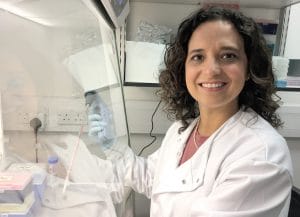 Dr. Alexandra Santos
Dr. Alexandra Santos New diagnostic tests are being developed that aim to more accurately diagnose a patient’s food allergy. Currently, skin-prick testing and blood tests provide insight into whether someone is allergic. But they are not the most reliable tools.
“Allergists don’t have a test that’s highly accurate for diagnosing food allergy. When you look at the tests that are out there, they’re in about the 80 percent accuracy range,” says Dr. Hugh Sampson, an allergist and professor of pediatrics in the Icahn School of Medicine at Mount Sinai in New York.
To definitively diagnose a food allergy, an allergist might perform an oral food challenge. But these are time-consuming, costly and come with reaction risk.
“We want to reduce the number of patients who have to go through challenges,” says Dr. Alexandra Santos, a pediatric allergist and researcher at King’s College London in England.
Basophil Activation (BAT)
The newer basophil activation test simulates an oral challenge, in a test tube. The patient’s blood is drawn, exposed to the allergen and the basophils – immune cells involved in a reaction – are analyzed using a technique called flow cytometry. Santos says this test is highly accurate in either diagnosing or ruling out allergy.
“We can reproduce really closely what happens in the patient when they are exposed to the allergen.”
There are limitations, though. The test preferably should be conducted within hours of the blood being drawn, and the blood needs to be analyzed in a lab that can perform flow cytometry, which isn’t available everywhere. In some cases, it’s not possible to stimulate the basophils, says Santos. So for some people, the test won’t work.
While the test is used in research studies, it is so far only being used clinically in a few European countries. However, Dr. Kari Nadeau, director of the Sean N. Parker Center for Allergy and Asthma Research at Stanford University, whose team has conducted research on the test, says it’s “taking root” in the United States as well. She thinks it could be used more routinely in the near future, and potentially used to predict allergy severity.
Epitope Mapping
This novel food allergy test involves a proprietary epitope mapping platform that looks at how a patient’s IgE antibodies bind to individual parts of the protein’s components, called epitopes.
From years of studying patients and looking at patterns of IgE binding in comparison to how a patient responds after eating, Sampson has developed a test that would show, with about 95 percent accuracy, if a person will be allergic to peanuts.
 Dr. Hugh Sampson
Dr. Hugh Sampson The technology has been licensed to the company Allergenis. It also has the potential to predict: whether sensitivity to an allergen will develop into an allergy, who will have a severe reaction, who will see success in oral immunotherapy treatments and, in the case of milk or egg, who will be more likely to outgrow an allergy.
“We’re hopeful the technology will be as good as it seems it will be,” says Sampson. The peanut test is expected to be available in the fall of 2019.
Mast Cell Activation (MAT)
Another holding promise is the mast cell activation test, for which mast cells are grown in a lab and then mixed with the patient’s blood plasma.
The plasma binds to the mast cells to reproduce the patient’s mast cells, and then is exposed to an allergen and analyzed using flow cytometry to see how the mast cells react.
Santos, who is also working on this test, says it is accurate in diagnosing a food allergy when it is positive, but less accurate in ruling out a food allergy. She sees the test being used as an additional screening tool, before oral food challenges. For example, if skin-prick tests and blood tests show sensitivity, then a MAT test could be performed. If it’s positive, it is definitely an allergy. If it’s negative, then it’s time for an oral food challenge.
The test can also be used where the basophils won’t activate. The MAT test is relatively new – Santos first published research on it in early 2018. It is still being validated and is not yet being used clinically.
Get more news from Allergic Living to your inbox.
Read More:
What You Need to Know About Food Allergy Testing and Proper Diagnosis
How to Prepare For Your First Visit to the Allergist





